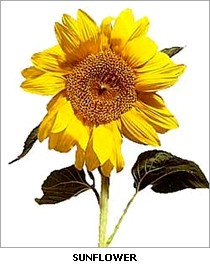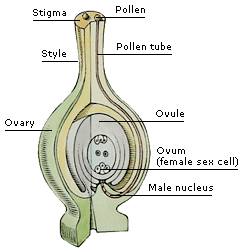DK Nature: Flowering Plants
This is the most abundant and widespread group of plants on Earth. Flowering plants are found in most habitats, from deserts to polar regions, and include species of trees, shrubs, and herbs. The flowers are the reproductive structures that produce new plants.

Some plants have one flower each. Others have groups of flowers, called flower heads. The head of a sunflower is made up of many tiny flowers grouped together.
The male sex organs (anthers and filaments) surround the female sex organs (ovaries). Flower parts are arranged in rings from the outer petals to the inner ovary. Their purpose is to encourage POLLINATION so that SEEDS can be made.
The 8,000 species of grasses are plants with small flowers. Grasses provide food for many grazing animals, including buffalo and zebra. Grasses can also provide food such as grains as rice, wheat, and corn.
There are some 250,000 species of flowering plants. These make up over 80 percent of all plants on Earth, and are divided into two groups:
| The 70,000 species of monocotyledons, or monocots, include grasses, lilies, irises, orchids, and palms. |
| The 180,000 species of dicotyledons, or dicots, include roses, magnolias, cacti, daisies, and lupins, and most types of tree. |
Flowering plants are divided into two groups. Monocotyledons have one cotyledon (seed leaf), which is the food store of a seed. They also have leaves with parallel veins, and flower parts in multiples of three. Dicotyledons have two cotyledons, leaves with branching, netlike veins, and flower parts in groups of four or five.
The transfer of pollen from a male anther to a female stigma is called pollination. If male and female sex cells from the same species come together, fertilization takes place and seeds are made. Pollination occurs in various ways, such as by wind or by animals.
Many flowers attract pollinating animals with a sweet, sugary liquid called nectar. If an animal feeds on the nectar, it picks up pollen and carries it to other flowers that it lands on.
Pollination in some flowers occurs when pollen is blown from other flowers by the wind. Animal-pollinated flowers are strongly scented and brightly colored, but the flowers of wind-pollinated plants, such as grasses, are often small, with no petals.
If fertilization occurs in a flowering plant, a seed forms inside the flower’s ovary. The seed consists of a tiny embryo plant, a food store for the embryo, and a protective coat.
As the seeds of plants develop, the ovary surrounding the seed develops into a fruit, such as an apple or a pea pod. Fruits protect seeds, and help disperse them away from the parent plant so that new plants have enough water and light to grow.


